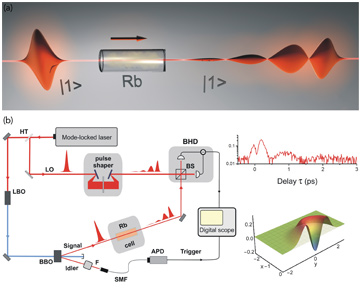 Concept (a) and setup (b) of experiment for generating and detecting zero-area single-photon pulses, with measured time profile (c) and reconstructed Wigner function (d) of the deformed zero-area single photon.
Concept (a) and setup (b) of experiment for generating and detecting zero-area single-photon pulses, with measured time profile (c) and reconstructed Wigner function (d) of the deformed zero-area single photon.
Single photons are ideal information carriers. Their interaction with simple, two-level atoms constitutes a textbook exercise in quantum mechanics, and lies at the core of many proposals for manipulating and storing quantum information. Yet what makes photons particularly good at transporting information—their limited interaction among themselves and with the surrounding environment—also poses a major challenge for developing a completely optical quantum processor.
One possible solution lies in hybrid photon-atom approaches, in which atoms are used for manipulating and storing quantum information and photons are used to transmit the information among different network nodes.1 Since most atomic systems, ranging from ultracold samples to hot vapors, have absorption linewidths in the Hz to GHz range, common sense suggests that an efficient coupling can be achieved only with correspondingly narrowband resonant single photons, and many current efforts aim at producing light quanta with these characteristics. Ultrashort single photons with bandwidths in the THz range, by contrast, are generally considered useless for this purpose, given their very weak interaction with atoms.
In recent experiments, we have shown that this need not be the case.2 Against common intuition, a single photon of extremely short duration, and thus possessing a wide range of different colors, can still strongly interact with very monochromatic atoms.
We observed the clear signature of such a strong transient coupling by sending ultrashort light pulses—each containing exactly one photon, produced by heralded spontaneous parametric down-conversion—through hot resonant rubidium vapors in a cell. The input and output quantum-optical states were then analyzed using a spectrotemporal-mode-selective homodyne detector recently developed by our group.3 The interaction profoundly modulated the photon’s temporal shape, giving it positive and negative lobes that resulted in a null area. Due to the huge bandwidth mismatch, however, almost no absorption took place—so that a single, heavily deformed photon with a clearly negative Wigner function was still present at the exit of the cell.
Realizing zero-area single photons is fundamentally intriguing, because it clashes with the standard view of the process, associated with a sequence of absorptions and stimulated emissions of different parts of a classical light pulse. Our findings may also open exciting perspectives for novel quantum technologies, in which ultrashort single photons can encode quantum information in their spectrotemporal shape and efficiently couple with atoms for its storage and manipulation.
Researchers
Marco Bellini (bellini@ino.it), Luca Costanzo, Daniele Pellegrino and Alessandro Zavatta, Istituto Nazionale di Ottica (CNR), Florence, Italy
Antonio Coelho, Centro Universitário UNINOFAPI, Teresina, Brazil
Milrian Mendes, Katiúscia Cassemiro, Lucio Acioli and Daniel Felinto, Universidade Federal de Pernambuco, Recife, Brazil
References
1. A.I. Lvovsky et al. Nat. Photon. 3, 706 (2009).
2. L.S. Costanzo et al. Phys. Rev. Lett. 116, 023602 (2016).
3. C. Polycarpou et al. Phys. Rev. Lett. 109, 053602 (2012).
